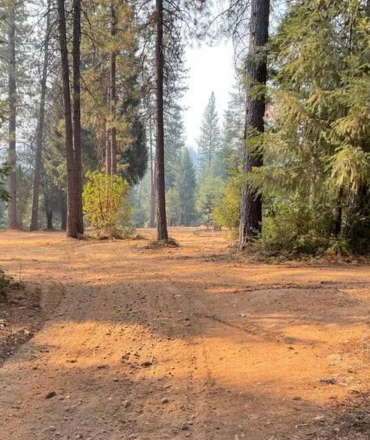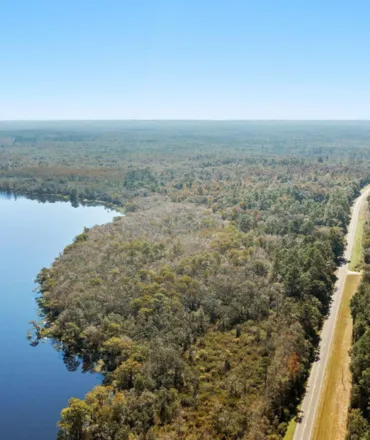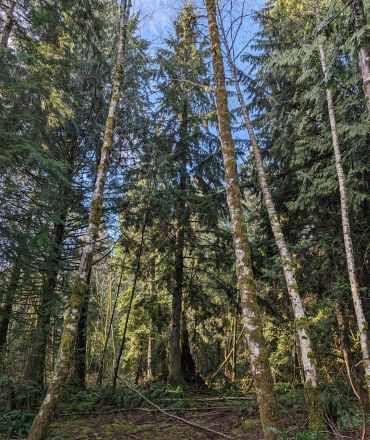Can group buying land make it affordable?
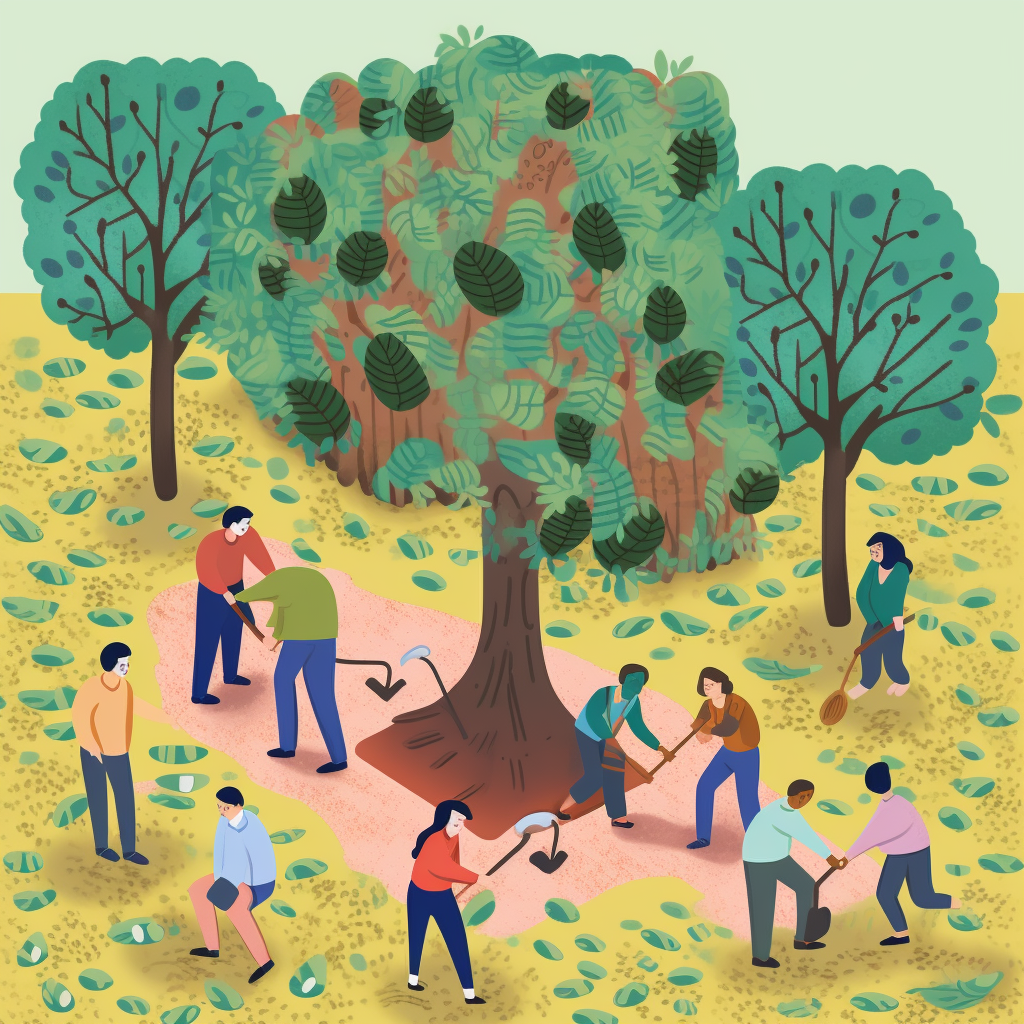
Purchasing a property together with others can offer financial benefits, and create lasting memories. Let’s explore this unique living arrangement and see how it could work for you!
This post is long and detailed and it’s intended for those of you who are interested in buying tiny house land with friends or partners. There are many ways to buy land for your tiny house. In this article we’ll cover the one we believe works best for most people in most situations.
From sorting out finances and subdividing the parcel between all involved parties to understanding zoning regulations and filing paperwork, there are several considerations one must make before buying Land together:
- How do I find land to build my tiny house?
- What are the rules for building a tiny house on land?
- Is there a way to find out what is permitted in my area of choice?
These are just a few of the many questions you might be asking yourself as you search for land for your tiny house. Although it isn’t as difficult as it used to be, still it isn’t easy to find land for your tiny home.
Buying Land collectively can be an incredibly rewarding experience if it’s done right.
Tiny homes are a relatively new type of home, so most states and cities are still not ready to approve or zone land for tiny housing. You don’t have to worry about it, with the tips and resources we provide below you can easily find land suitable for your tiny home and more importantly using the power of group buying you can acquire land that otherwise would cost X-thousands of dollars more!
Don’t overpay for land. It will ruin your finances – join oTinyHouse land buying club and save 10x on your land purchase 🙂
Many people claim they would like to buy land for their tiny house and be independent. Few people do, most continue renting.
Many tiny house owners wonder how to afford the land purchase. Establishing shared property ownership with friends or people we share the same values with it’s not easy. Most people will either end up living by themselves or with their families.
Buy Your Own Piece of Land with Friends or Community Members
You can buy land to build a tiny home. Tiny homes take up a lot less space than traditional homes, and they can fit on lots that already have one home. Finding out where you want to live is the first step. Most of us know that this is where we are currently living and working, so it helps to narrow down the options.
Sites you should use in your research:
They give you access to land in urban, suburban, or rural areas and include lots for sale and prices that you can filter by location and price. These are just a starting point. However, they can help you to get a better understanding of the land available in your area and the size lots that might be available.
Tiny Homes on Wheels
These RVs are subject to regulation and must be registered with the Department of Motor Vehicles in your home state.
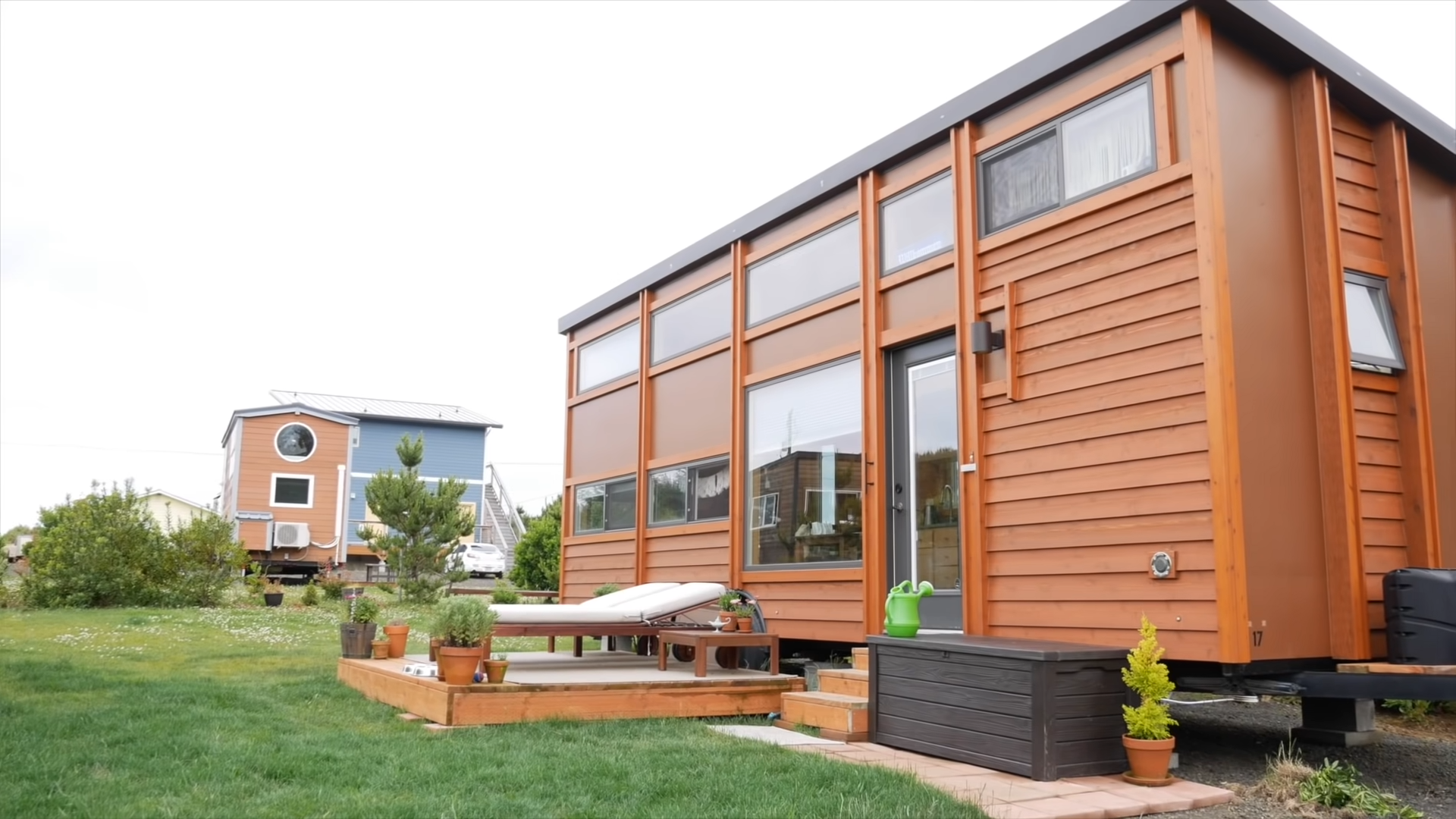
Once you have that taken care of, you can park it and live there just like you would in an RV. However, not all campgrounds and RV parks have kept up with the times.
Many refuse to let THOWs stay in their parks. Although you can put your tiny home in the backyard of a friend or neighbor’s driveway, there are regulations and ordinances involved and they vary from state to state and county to county.
You can’t live in an RV full-time outside of an RV park in most areas of the United States. Some places with many retirees or snowbirds, such as Arizona and Florida, can be exceptions. They understand the benefits they could provide and have laws that are friendly to seasonal residents (you can check some of the tiny house friendly states here).
Foundation-built Tiny Houses aka Accessory Dwelling Units
Tiny homes built by foundations have different regulations. These tiny homes are legally called Accessory Dwelling units (ADUs). They have many different requirements in terms of square footage, bathrooms, and egress windows. A lot of people are open to the idea of ADUs.
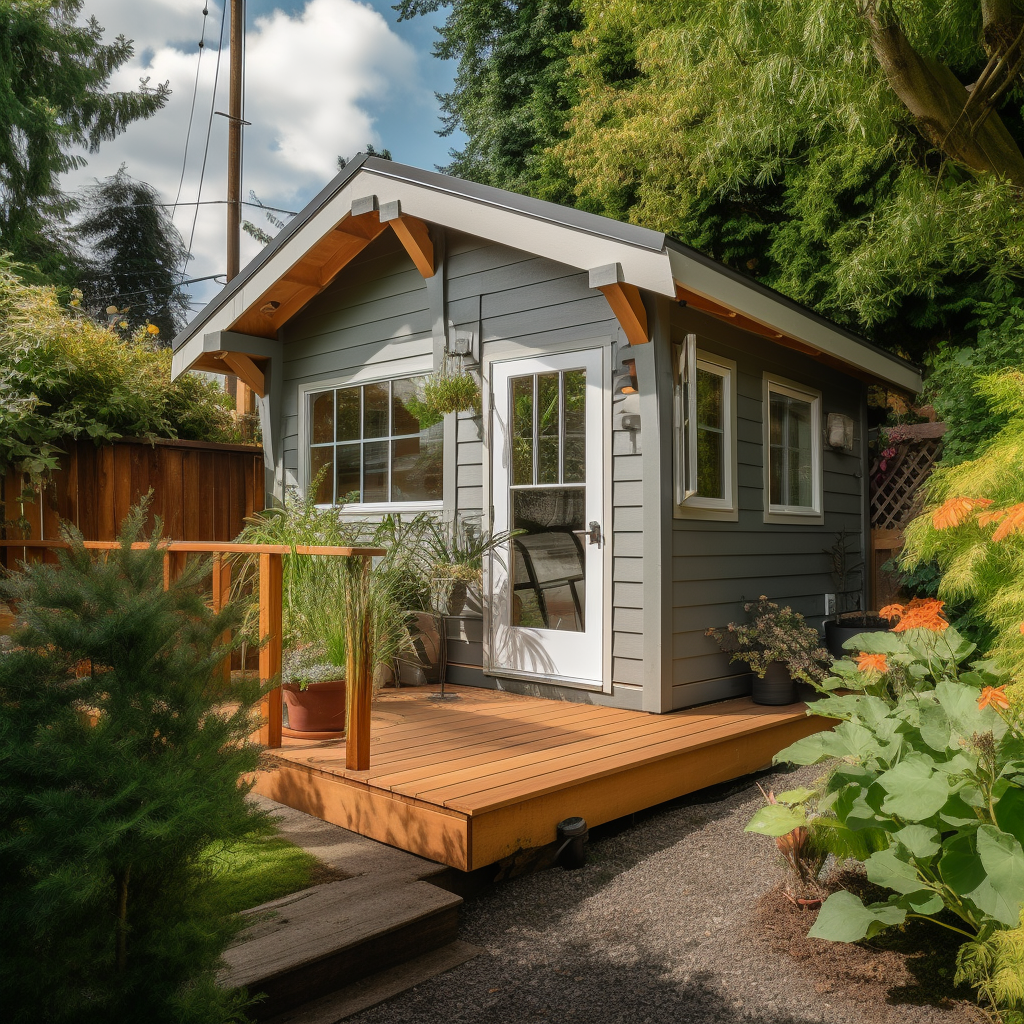
One of my favorite resources for ADU regulations can be found on Accessorydwellings.org.
These provide city-by-city information on the ADUs’ specific building codes and zoning regulations. ADUs are accepted in California, Minnesota, and Utah. However, the building requirements for each state and city within them vary.
You can watch the video below to learn about ADUs. — it’s comin 🙂 still working on it!
Be Open to Alternative Arrangements
Your family and friends are a great place to start your search. Many people I know have found an aunt, uncle or third cousin who had large yards or back acres that were perfect for a tiny house.
You won’t need power or sewage connections if your home can be completely off-grid. This makes life much easier as you only need a water hose connection and a parking spot.
If you have exhausted all your existing networks, don’t hesitate to look for online resources. Craigslist is a popular place to advertise a driveway or back yard for a tiny home.
To find out if anyone is interested in renting a small space, you might consider posting a question to sites such as Nextdoor or Craigslist.
A great resource is the tiny house community. Talking to people who live and breathe tiny lives is a great way to get information about specific problems in tiny houses. Reddit and Facebook are great places to start. You will find tens of thousands of people in groups that deal with tiny living.
You can still attend amazing festivals and meetups, even if you are just starting out.
Tiny House Festivals/Local Real Estate Brokers
Local real estate agents are last but not least. Quality real estate brokers and agents are more knowledgeable about local news and properties available than anyone. They might know where the best spot is, or be able point you in the right direction to a tiny house community. For a list of upcoming 2023 Tiny House Festivals check this article.
Tiny Home on Wheels: Building Codes & Certification
You must build your tiny home to RVIA/ANSI standards if you plan to travel in it.
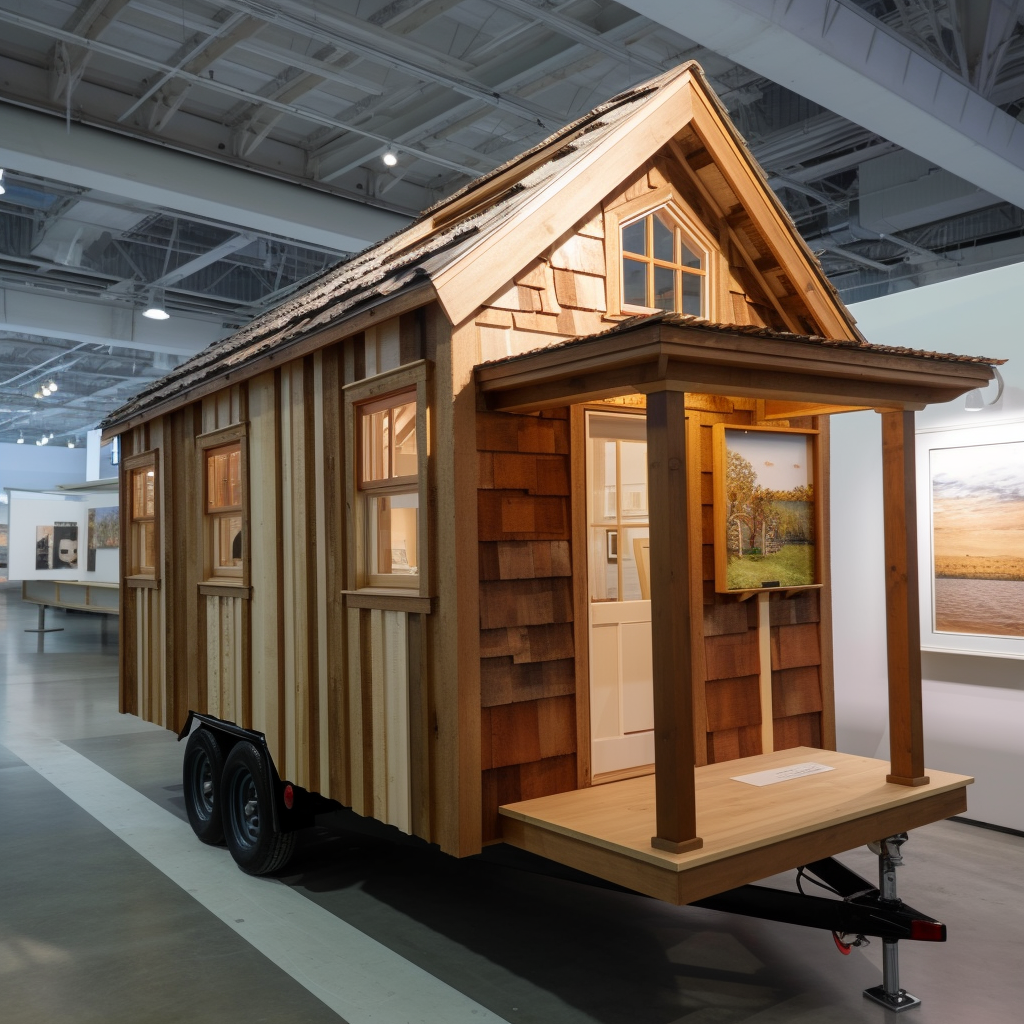
RVIA certification stands for Recreation Vehicle Industry Association certification. It is a program that provides a standardized certification process for manufacturers of recreational vehicles (RVs) in the United States.
To obtain RVIA certification, manufacturers must meet certain standards for quality, safety, and environmental responsibility. Park models are following different guidelines more focused on plumbing, sewage and egress routes. They also include window placements and internal height. While compliance does not guarantee you will be allowed in to every RV park, it can make it more likely.
The other common certification ANSI (specifically ANSI A119.5) is a set of standards that specifies requirements for the construction, design, labeling, testing, and certification of park model recreational vehicles to ensure their quality and safety.
ANSI A119.5 is a standard developed by the American National Standards Institute (ANSI) that sets specific requirements for park model recreational vehicles. A park model is a type of RV designed for extended stays and typically used as a temporary or permanent residence.
The ANSI A119.5 standard specifies minimum requirements for park model construction, including size, weight, and safety standards. It covers various aspects of park model design, such as structural integrity, plumbing, electrical systems, heating and cooling, and appliances. The standard also includes requirements for labeling, testing, and certification of park models. The purpose of the ANSI A119.5 standard is to ensure that park models are built to a consistent level of quality and safety.
Utility Considerations
You have found the perfect piece of land for your tiny home. But does it have water and power? If there is no power available, you will need to either create it yourself or hire someone to bring it to your home. It will cost more to connect your property to utilities if you live further away. There may not be enough utilities in some areas. The same goes for water. You will need to transport water from the city if it isn’t readily available.
Finding undeveloped land with utility connections is the best option but… you should consider the maintenance and upfront costs of off-grid power options like a solar power system or wind turbine. The good news is that smaller houses will require smaller systems and it may translate into significant cost savings. A composting toilet is another option that’s popular for small houses. You can make compost from the byproduct. The Humanure Handbook explains how to properly implement this type of composting system. A greywater filtration system can be used to manage household water and urine. This type of water and waste management may not be allowed in your county or municipality – consult your local regulations.
| Utility Type | Description | Cost Range | Considerations |
|---|---|---|---|
| Electricity | Connecting your property to the grid or generating your own power | $1,500 – $30,000 | Distance from the grid, local utility fees, off-grid power options like solar or wind power |
| Water | Connecting to city water or drilling a well | $1,500 – $10,000+ | Availability of city water, well drilling costs, permits fees |
| Sewage | Installing a septic system or using a composting toilet | $1,000 – $5,000+ | Size of the system, local regulations, alternative options like composting toilets and greywater filtration systems |
**Note**: Costs may vary depending on location, specific requirements, and local regulations. Always consult with local authorities and professionals for accurate pricing and feasibility before making any assumptions – quite often the price will vary a lot depending on who you speak to.
Access and Water Rights
Water rights are an important aspect of off-grid living, as I explained in my article on off-grid water systems. You don’t automatically get the right to water on your land if you purchase it in the west U.S.
It is more likely that the water you use to water your land has been allocated to industrial or agricultural projects. It’s a good idea to find out if your land comes with water rights if you plan to grow anything on it.
Access rights are another important aspect. Many rural properties don’t have any road infrastructure. Many rural properties are not even near a road, and depend on easements from nearby property owners. You should wait for a property that has full access to a state-maintained or county road. It can be very frustrating to have to negotiate access with neighbours. It is better to connect to a nearby street.
Look for New Opportunities
Flexibility is the most important thing when it comes to finding a place to live in a tiny house. We are still learning a lot about the tiny house movement. Parking and building lots. It’s much easier to find the perfect place for your tiny home if you are able to accept defeat and change as necessary.
Anyone who has ever worked on a complex project knows that good process is the most important aspect of moving through obstacles. Achieving results is easy when the process and tasks are flowing. Co-buying land is a bit more complicated than buying on your own and having a process that you can trust when it becomes tedious will help you move forward and be successful.
It is common to co-buy property and it can be hard work with many setbacks. You need to love the process and be positive about it to get through the grind.
A good process = tiny community potential
Bad process = No moving forward.
Why is it so difficult to buy land with other people? Does it mean that it is not possible to co-buy tiny house land with others?
The banking system we have is for owners who are single or married. To buy a tiny house patch of land you will likely need to raise funding from multiple parties and organize it creatively. The existing regulations and infrastructure were designed for single persons or families. You will likely need to change zoning or build wider roads to make it more suitable for larger groups of people in order to meet the local zoning and building requirements.
The Building & Zoning code has not heard of co-living and to build a tiny house village, you’ll need permits that are difficult to obtain. Don’t be discouraged – the reward of building community is worth it and you will also love The Process of getting there.
<>
The People: Choose Your Co-Buy Team
The foundation of achieving success is who’s your partner. You must ensure that your dreams are built on solid foundations. In this instance, your land purchasing partner is not everyone who might be interested. Your land partner should be the group of people involved in the initial purchase of land – people who are motivated and willing to work collaboratively with you.
This is what the shared land owners team needs to do to succeed.
<>
You and your partners are about to make common mistakes such as:
- Fuzzy squad: Make sure you know who is committed and who’s not. All participants should know who is part and who isn’t. A group of partners that is not clearly defined can make it difficult to find alignment.
- Participants who are dead weight: It is not easy to gain alignment and triangulate people’s requirements. It is important to work with people who will actually help you make your dream come true. Not just those who are available to answer a Facebook comment or attend a meeting. People who are less committed can become residents or investors later. A tiny house land co-buyer’s team must have a solid core.
- You don’t have financing: Your land Co-Buyers team may not be able to provide the $400k down payment required. You and your land buying team needs people with financial resources, or financial assistance through friends and family.
Clearly define the basic requirements for your tiny house community
All members of the community should understand the difference between ”must haves”, and ”nice to haves”.
These are the four basic elements we recommend that people define before they embark on a co-buying venture:
- Geography
- How many people who will be living there
- Must-have features (create a list)
- Bells and whistles – use a dollar value to visualize the scale ($ through $$$$).
Example: This is how we defined the requirements in the ”GrandCanyon X”
- Geography: It takes approximately 35 minutes to get by public transit to a town (jobs).
- Number of people who will reside there: 10-15
- You must have: A nice outdoor space and three plus private units which could accommodate families
- Bells and whistles: $$ from $$$$
Common mistakes with describing housing requirements:
- Too broad in geography: If you don’t have a clear vision of where you want to live, the search for properties can become endless. It becomes hard to compare projects.
- Avoid highly-detailed conversations like ”what sort of bells and whistles we need”. This can cause a project to fail.
- Don’t be too strict with your requirements. You will need to have flexibility in order to achieve this. Land constraints such as availability and zoning can quickly reduce the number of viable projects. Do not confuse ”nice to build” with ”must-have.”
- Finding financing: This is the biggest deal. Depending on how the steps turn out, you might have to scrap the blueprints and go back to ”Who should be part of it”, or ”What are the housing requirement” if financing is not available.
Let’s brake the process of buying land together down into five sub-steps.
Step 1: Evaluate your total buy and build project cost (”TPC”)
<>
TPC refers to the total cost of the property, including any renovations or buildings that are necessary before the property can be occupied. The TPC is the price of the house. The TPC for a vacant lot and 5 tiny homes built on it would be the land cost plus the cost to build them.
It is best to use three factors to determine the value of your project.
1) For real estate in your region, cost per square foot (sq. ft.). Zillow provides charts that show this cost for each city. For example Oakland, CA averages $521 and we will use an estimate of $500-600 for the Bay Area (which is horrendously expensive).
2) Per person, square feet are needed: 300-500 was our preferred range. RGB measured 300 sq. ft. per person. This was dense, but still livable. 500 is more spacious, but it’s still urban.
3) Number of people: How many people would you like to live on this property? We set a goal range of 1-15.
These three factors were multiplied at ”GrandCanyon X” to give us an estimated TPC between $1.5 and $4.5 million. So we started planning for a $2m-$3m project.
| Factor | Range | Example Value |
|---|---|---|
| Cost per sq.ft. | $500-600 | $521 |
| Sq.ft. per person | 300-500 | 400 |
| Number of people | 1-15 | 10 |
Using these example values, you can calculate the Total Project Cost (TPC) as follows:
TPC = (Cost per sq.ft.) x (Sq.ft. per person) x (Number of people)
TPC = ($521) x (400 sq.ft.) x (10 people) = $2,084,000
This gives you an example TPC of $2,084,000 based on these specific values. Keep in mind that you can adjust the values within the given ranges to find a TPC that best suits your project.
Step 2: Down payment needed (cash money required to start the process)
Next, you need to determine what your down payment will look like. This is a crucial ”uh, can this really be done?” moment. If your co-buy team doesn’t have enough cash to pay the down payment, then you should return to ”The Who should be part of the project” or ”The What are the housing requirements”, and reduce your project requirements.
<>
Step 3: Determine how to reward financially contributors
Now you are aware of your down payment requirements. If you’re buying property for a large group, it can be quite scary. (We had a moment when we calculated this number for future ”GrandCanyon X”). You will need to invest some serious money and quickly determine what financial contributors get in exchange for their contributions.
These are the ”Big 3 Questions” we consider to be important.
1) Is there a return on investment? What is the return?
This is a crucial fork in your journey. This is likely to be one of the two options. Either they will buy the space and not rent it (a la cohousing), or they will pay rent. The financial return for the first scenario is the same as that for someone who purchases a home to live. While the home’s value might increase or decrease, there is no monthly profit from renting. The second scenario offers the possibility of creating a monthly income. Those who financially contributed can also get a steady financial return.
It’s a good idea to compare where people are investing their money with the return. In the past 50 years, the S&P 500 has returned about 8% annually. The Bay Area might see a 4-6% annual return in rental income (not including appreciation).
2) What/when do I get my money back
Here are some options:
- Your money is locked up for an unknown time.
- We will make the property available for sale in X years. You will receive your money back.
- Future residents will need to invest in the project.
- We will refinance your project. This will bring in extra cash (sometimes called ”cash-out refi”, or ”takeout refi”) Then, you will receive your money back.
Investors will be interested in knowing when these events might occur. It is important to have a good idea of when the property may be sold and a solid story about who/when/why they might be acquired by others (and how that price would be determined).
3) Who makes big money decisions?
Some of the big money decision include:
- When should we sell?
- Do we do a major renovation?
- Do we refinance?
- How much rent will it cost?
Financial contributors will be interested in knowing who makes those decisions and if they have any input.
There are several ways to deal with how decisions are made:
- Have financial contributors vote according to how much they contributed
- Appoint a single manager to make decisions for the group
- Do a combination of #1 & #2, where most of the day-to-day decisions will be made by a manager but big decisions (e.g. When do we sell? are voted by the financial contributors.
And example of the Big 3 Questions that we Answered when We Started ”GrandCanyon X”
<>
The system to adopt decisions and solve conflicts
We made the decision early that renters would pay rent. This would allow us to make regular profits for financial contributors. We wanted flexibility and inclusion in who lived there, rather than forcing residents to ”buy” their part of the living space. Renting is a great way to achieve this.
| Topic | Description |
|---|---|
| Renting | Renters would pay rent, allowing regular profits for financial contributors and promoting flexibility and inclusion in the community. |
| Timeframe | “GrandCanyon X” is a temporary community with a planned lifespan of 5-10 years. This allows financial contributors to expect a return on their investment within a set time frame. |
| Stewardship | The organizing team is responsible for the management and decision-making of “GrandCanyon X,” while financial contributors are passive in terms of decision-making. |
| Perpetual Communities | These types of communities have a more complex structure, often involving shared ownership and long-term commitments. “GrandCanyon X” is not designed as a perpetual community. |
Step 4: Make soft commitments (the not so-easy money conversations)
Now that you have the information you need to make the right cash decisions and answer the Big 3 Questions, you can go out and start having those awkward money conversations. This is no longer about hydroponics and tiny homes and organizing the garden. It’s now about checking account balances, and predicting returns.
Get soft commitments. This is how a soft commitment sounds:
”I will probably put in $100k if I buy a property within a year that is similar to what you suggested”
A soft commitment should include:
- How much money?
- When – a time frame?
- Understanding and alignment of The What are the housing requirements as well as the Big 3 Questions.
All these elements should be part of the commitment. These conversations are difficult, they are not like the ones we used to have with our friends, but at this stage you need real commitment with actual numbers. You can’t continue forward if the commitment is not 100% clear. You can channel your inner calmer version of yourself and learn to love these money and commitment conversations.
Step 5: Do a dry-run to confirm that bank financing is in fact available
[Loans are a huge topic. This is a longer OTH article on how to think about loans.]
Ok, now you have cash commitments. Great job!
Next, confirm that a bank will lend money to you. Don’t make assumptions. Banks are not interested in co-buying. This is your job.
They will finance single-family homes in the suburbs all day – any day because it’s what they are used to and have all the forms and procedures in place to make it happen. They will find it less familiar and comfortable to do what you are doing.
We recommend that you test financing before making an offer. Usually it’s too late to make an offer on a property while you are trying to negotiate a loan with yet another bank. It would be a shame to lose your dream tiny home land because you didn’t do enough research.
First, determine who will be taking the loan.
Will the entire co-buy team be on the loan? Who will be responsible for the loan?
Banks typically won’t allow more than four people to borrow money. Don’t bring more than four people to a bank. Most likely, you want to have as few people as possible who have enough financial resources to be eligible.
Next, search for a property that matches your requirements
Pick a property that is near your dream property, but not one you intend to buy. You should find a property that is roughly the same price and of a similar type (e.g. It could be empty land or an apartment building).
This property will be your test property to see if you are eligible for a loan.
Testing the waters …
You now need to tell lenders that you are interested in purchasing that property. Even though this is a test for you and your group for them it will be business as usual.
The bank (or mortgage brokers) underwriters will guide you through the process. They will evaluate your creditworthiness. They will decide whether or not they are willing to lend against this type of property. This process will teach you a lot!
You’ll receive either a ”pass” or an indicative terms sheet with interest rates. This information is very useful and will help you prepare for the real land purchase deal.
You might not receive any term sheets. This is a sign that you should either adjust your group of co-buyers (to increase your chances by providing more financial backing in the eyes of the lender) or change the type/size of the project.
Here are some considerations regarding types of loans
There are two types of loans that you should consider: a residential loan and a commercial loan.
| Loan Type | Description | Key Factors |
|---|---|---|
| Residential | A loan for purchasing a single-family home or a small multi-unit property (usually up to 4 units) for personal use. |
|
| Commercial | A loan for purchasing larger multi-unit properties, mixed-use properties, or commercial properties, primarily for generating income. |
|
Notice: Multi-unit residential loans may require a pro forma in order to show what rents you might collect from units you aren’t living in.
It pays to speak to several banks
Shopping around for bank loans is one of the best ways to save money. There are many variables. A few extra phone calls can help you save $20k, $50k and even more over the life of your loan. It’s important to speak to different types and banks and mortgage brokers. Big banks are interested in easy straightforward transactions, so you are better off if you can find small regional banks. You can also find online lenders such as Quicken Loans. Fannie Mae, Freddie Mac and other agencies have their own lenders who offer commercial loans. They may all be the right lender for you.
Take a look at all the relevant ones.
Step 6: Choose a legal structure
Most frequently asked question here is about legal structures to facilitate co-buying and shared land ownership. This might seem strange, since it isn’t something that you’d expect to see until you’ve gone through all of the previous steps. The legal structure shouldn’t be the starting point – it should be what you end up with as an outcome of the decisions you made in the previous steps.
<>
High level take on the legal structure selection process (a great starting point, but you should research the subject more)
<>
The most important questions that will determine your legal structure are:
- What type of property it is?
- Are there renters or only resident-owners who do not pay rent?
The majority of people end up with an LLC, HOA or TIC.
Decide how you’ll hold the title
Every land purchase is evidenced by a piece of paper a ”deed.” It explains the relationship between the co-owners (”grantees”) and the title. This sounds very legalistic but it could have real-world consequences, especially if you decide to part ways with your co-owner.
The main options for sharing a title with a partner are:
As tenants in common (TIC) ownership or as joint tenants with right to survivorship (JTWROS). It is important to know the differences between joint tenancy and tenancy-in-common tenancy. This is especially true when one party wants to sell or dispose of their ownership interest.
A tenancy-in-common (TIC) eliminates the need for a 50/50 split. You and your co-buyer can own a different number of shares in the property. If one of the co-owners dies, their share is transferred to the beneficiary of their estate, usually a spouse or children. It is quite common for unrelated co-buyers to purchase a title by stepping into tenancy in common (TIC) agreement.
A joint tenants with right to survivorship (JTWROS) allows you and your co-buyer (in most states in the U.S.) to have equal rights to the property. You each have a one-third share if you purchase a property together with two other people. The remaining owners will inherit the interest of the deceased tenant if the other tenant dies. This occurs automatically without the need to go through a probate or court process. Even if the deceased owner had made a will stating that the property would be passed to another person, this request would normally be denied.
| Ownership Type | Description | Advantages | Disadvantages |
|---|---|---|---|
| Tenants in Common (TIC) | Co-owners hold separate and distinct shares in the property, which can be unequal. When one co-owner dies, their share passes to their chosen beneficiary. |
|
|
| Joint Tenants with Right to Survivorship (JTWROS) | Co-owners have equal ownership rights in the property. When one co-owner dies, their share automatically passes to the surviving co-owners. |
|
|
Similarities between TIC and JTWROS Ownership
Joint tenants with right to survivorship (JTWROS) and tenancy-in-common (TIC) give you each an ”undivided” interest in the property. This means you can use the whole property and there are no internal borders. Co-owners can not simply sell the property and divide it in half. Instead, the other co-owner would have to sell the tenancy or interest. The seller would have the same rights, but the buyer would be able to use the whole property.
You may also find some less common structures, such as PRECs and community land trusts, that maximize long-term community ownership.
To make your operations easier, choose a widely adopted business structure (for example LLC). Investors know what an LLC is, the banks are used to working with LLCs. The institutions you will work with have templates to work with LLCs and it’s less explaining. If you had success with other forms of property ownership, let us know – share what you learned. Experiment (if you have the time to)… There are many passionate people who want to make the world a better place. [note: We’d love to hear from folks using these structures in real projects … ”we@otinyhouse.com”].
Distribution of ownership
It is important to know what percentage each person will own in the event that one of you dies or sells your interest.
If you are joint tenants with right to survivorship (JTWROS), this is an easy decision. If there are two of your interests, you would normally split them into equal parts. For example, 50/50.
If you own the title as tenants-in-common (TIC) you don’t have to split your interests 50/50 nor on the basis of how much each of you contributes. One example: If you agree to maintain the property, or contribute more towards the down payment, one of you may decide that the other will get a higher percentage.
Who will pay for ongoing expenses?
You may have to pay mortgage payments, property taxes and insurance premiums. There are also costs for infrastructure, repairs and utilities. In your co-ownership agreement, you can indicate how these expenses will be allocated. Either you can allocate the costs at the same percent as ownership, or use the down payment contribution from each co-owner to fund the foundation. If you and your co-owner intend to use the property personally, instead of renting it out, you can allocate expenses based upon how much time each spends there.
OTH LLC Model
We love the ”GrandCanyon X” LLC Model. It can be applied to many situations.
<>
We’ll now dive into the details.
The ”GrandCanyon X” Model is applicable when there are multiple owners and residents rent their space to them rather than buying it.
This model has residents and owners wearing different hats. Although they may be in close proximity, they are conceptually distinct.
<>
- Peter is an owner. Peter is also a resident.
- Peter as a resident pays rent to the LLC (”The Community Tiny House LLC”)
- Peter as an owner receives quarterly cash dividends from the LLC.
- Peter’s ”effective rent” is the difference between his dividends and the rent he pays.
- Some people own more than their rent, for example Jenny owns 20% of the property, but only pays 10% rent due to the size and location of her home. Owners such as Jenny are paid monthly by the system.
- On the other end George pays more rent than he owns. In this case George contributes monthly to the system.
Everybody has the option to choose where they want to position themselves. As a member of the LLC you can either own more or rent more – It’s up to you. Your rent can change when you move to a different unit or living space. If you sell shares of the LLC, your ownership can change. It’s a flexible arrangement that allows movement in both directions.
Owners make decisions about when to sell, and the selected board of trustees are the managers of the LLC. Residents decide what they want, including ”who lives here” or ”how we organize a shared food program, shared garden space, shared tools, etc.” In the event of disagreement between co-owners, there are mechanisms for dispute resolution. Co-owners who fail to fulfil one of their responsibilities can have serious consequences on the property and thus there should be ways to deal with such situations
| Role | Responsibilities | Benefits |
|---|---|---|
| Owner |
|
|
| Resident |
|
|
| Owner-Resident |
|
|
How is property liability divided among co-owners?
Both as an owner and resident, co-owners should be involved in the decisions at all levels.
When tax time arrives, each owner receives a K1 form with their year’s profit and loss. We are considered a normal real-estate investment LLC from the perspective of the IRS, the bank and the insurance company – a very normal real estate investment LLC. All of the community planning, events and gatherings happen at the ground/community level. The LLC is the binding format for all of the human relationships we’ve built and continue developing.
What if a co-owner later wants to leave?
It may be difficult to get out of a co-owned land. You probably don’t want the other partners to be able to sell their interest to anyone (assuming that there is a market for a part of your land). This is possible, even though the title may be JTWROS or TIC. However, a co-owner doesn’t legally need to get the other’s permission to sell the interest.
A provision in the co ownership agreement can be used to circumvent this problem. It requires the selling co-owner of the interest to grant the person who is staying a right to first refusal to buy the interest. Despite this provision, the co-ownership agreement still needs to address several issues.
- How can you accurately assess the property’s worth for the purchase?
- Is the seller co-owner required to accept the buyout offer?
- What happens if the remaining co-owner is unable to raise enough funds to purchase the selling co-owner’s share?
- You can reduce your debt burden by sharing the purchase of a house. However, you need to carefully and thoughtfully decide if it is a good idea for you and your land co-buyer.
These are the most common errors we see when tried to make the tiny house project successful:
Not constantly re-evaluating if you have the right people and the project is achievable: For example many groups won’t have the financial resources to complete a project and will need to reevaluate the objectives. Pressure test your team and resource availability at the beginning and on a regular basis.
Don’t be put off and clearly define from the beginning who has the decision rights. These decisions can have a huge impact on the budget of all of your partners. These decisions should be taken seriously and every detail thought out.
Avoid complicated legal structures. Keep it simple and adaptable. Do not reinvent the wheel.
Co-buying property is becoming very personal with serious impact on capital. There are banks, investors, and insurance companies. The game can be played differently by any member of the team, and they may not be very happy about every single step of the process. In a world that values property highly, you will need to find a way to keep your values true and make things happen.
Locating land that matches your expectations
Let’s now talk about how to find your dream tiny house land.
Step 1: Define your perfect piece of land
Your ”perfect” piece of land is the type of property that you are looking for (the kind of property). Take note that not all properties are equally difficult.
Because our entire homeownership system revolves around single family homes, whether they are small or large homes, they are very easy to find. Small hack: If you think a single family home with a large plot of land is feasible for your group, go for it!
The next easiest are vacant apartment buildings that have up to four units. This is where vacancy is crucial. It’s much more difficult if there are already people living there. There is a lot of information available about the displacement of renters in the major metropolitan areas. I encourage you to read the subject if you are thinking of purchasing a tenant-occupied property. Dealing with tenants who are not willing to relocate may cause significant delays to your project.
Banks and local authorities usually consider five plus units to be a multifamily commercial property. Things like permits and infrastructure get more complex and sometimes expensive as you go up in the number of units.
It is a difficult option to buy two properties at the same time. It is important to make sure that all of your offers are aligned so that you don’t end up with half of what you need – which may cause part of your co-buyers to feel left out. It can be difficult to find properties that can be bought together because it is not easy to search for them. Usually in the property description you will see a reference to an adjacent lot if there is such an option – combining two or more lots can be a great option.
Working with empty land is the most difficult project. It combines all the difficulties of the previous projects, plus the difficulty in designing and building. Although the end result can be a big win for all, it is a long and difficult process.
Factors that impact the difficulty of building your ”perfect” property:
You will need to think about what improvements and human-made modifications may be required if you’re looking to buy undeveloped land or raw land to build a tiny house.
| Difficulty Level | Factors for Building “Perfect” Property |
|---|---|
| Not so difficult |
|
| Medium difficulty |
|
| Difficult tasks |
|
You must also consider how you will get your tiny house onto the property. An access road or driveway is essential. Before I was able to move on to the tiny house lot, I had to hire a contractor with heavy duty machine to grade, clear the land and cover the road with gravel – all together came to more than $4000.
Тhe total cost of any land acquisition could include the following:
- Property survey
- Soil and water testing
- Permit fees
- Engineering services
- Utility hookups
- Tree removal
Make sure you research the costs involved in developing your land for your tiny house RV. I recommend adding a few thousand dollars to your budget to cover any unexpected costs or fees.
Step 2: Start the on-market research + email alerts
”On-market” refers only to publicly available land for sale listings. Depending on the property type, you may use commercial aggregators such as Loopnet or Zillow, Redfin and Trulia.
<>
To get an idea of the market, you can receive a stream of property listings in your email – email alerts can be extremely helpful. Property is rarely on the market for long in hot markets such as the Bay Area. You will have less than two weeks to make an offer. No email alerts = missing your dream land.
<>
Step 3: Perform an off-market market search
Off-market searches are used to search for property that isn’t being officially sold. You might hire a RE agent to assist you. They may make cold offers for properties not yet listed for sale or refer you to someone who is looking to sell quickly but has not yet placed their property on the market. Many of the best deals are found off-market and finding them requires time and work.
We see common mistakes with locating land
It can be quite difficult to choose the right project (a project you can actually complete). Developing a tiny house village on vacant land is quite a project.
Missing opportunities that are off-market. Get an agent – they are paid no matter what property you purchase, and there is no additional cost to you.
Almost there!
You’ve now made an offer. Amazing work has been done. The fun is about to begin: You get a whole new set of exciting tasks to solve – property inspection, signing and closing the deal, obtaining building permits, and renovations.
We’ll save that for a later post. We appreciate you reading. You have won the tiny house advocate award of the day!
Do you find yourself in this situation? We would love to hear from and offer advice. Hit us up at we@otinyhouse.com

